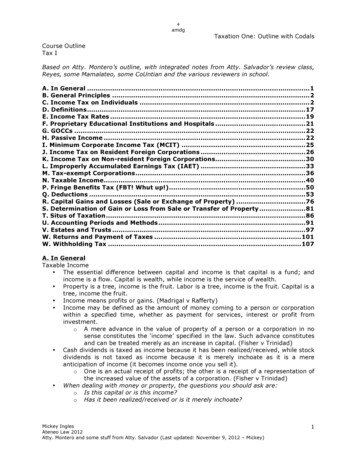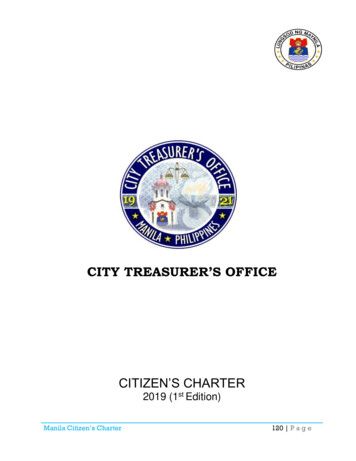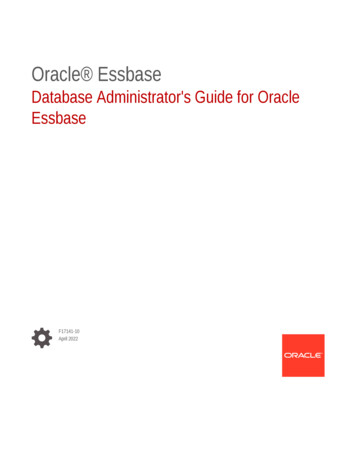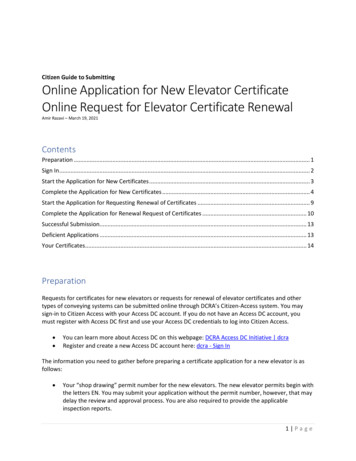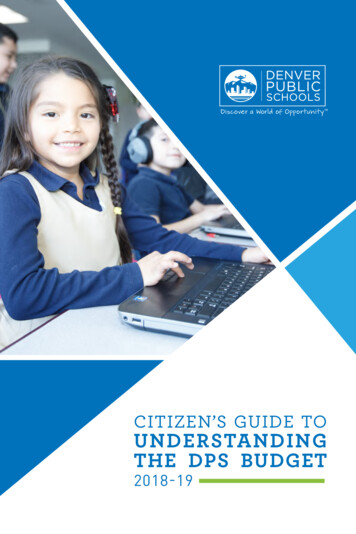
Transcription
CITIZEN’S GUIDE TOUNDERSTANDINGTHE DPS BUDGET2018-19
VISION: EVERY CHILD SUCCEEDSMISSION:The mission of Denver Public Schools is toprovide all students the opportunity to achieve the knowledgeand skills necessary to become contributing citizens in ourdiverse society.SHARED CORE VALUES:Students First Integrity Equity Collaboration Accountability FunTHE DENVER PLAN 2020:The Denver Plan 2020 is Denver Public Schools’ five-yearstrategic plan. With the vision of Every Child Succeeds, DPShas committed to five specific goals designed to close academicachievement gaps and prepare all students for success in collegeand careers:1.GREAT SCHOOLS IN EVERY NEIGHBORHOOD: By 2020, 80% of DPSstudents will attend a high-performing school, as measured by regionusing the district’s School Performance Framework.2.A FOUNDATION FOR SUCCESS IN SCHOOL: By 2020, 80% of DPS thirdgraders will be at or above grade level in reading and writing.3.READY FOR COLLEGE AND CAREER: By 2020, the four-year graduationrate for students who start with DPS in ninth grade will increase to90%. By 2020, we will double the number of students who graduateready for college and career, as measured by the increasing rigor ofthe state standard.4.SUPPORT FOR THE WHOLE CHILD: DPS is committed to creating anequitable and inclusive environment that fosters the growth of thewhole child by ensuring students are healthy, supported, engaged,challenged, safe, and socially and emotionally intelligent.5.CLOSE THE OPPORTUNITY GAP: By 2020, the graduation rate forAfrican-American and Latino students will increase by 25%. Readingand writing proficiency for third-grade African-American and Latinostudents will increase by 25%.PG 2 DENVER PUBLIC SCHOOLS CITIZEN’S GUIDEABOUT THE CITIZEN’S GUIDE FORUNDERSTANDING THE DPS BUDGETThe Citizen’s Guide to Understanding the DPS Budgetsummarizes the philosophies and influences that drive howDenver Public Schools spends its funding.These considerations include student enrollment, state funding,district reserves and the key belief that our schools best knowhow to serve their students. In addition, the guide provides detailson how the voter-approved Mill Levy Override and bonds supportstudents and families. Please note that the guide is not a completedirectory of financial information. Fully detailed budgetary schedulesare available on the DPS Financial Transparency website cy.
s0.6%4%3.2%AmericanIndian StudentsOther StudentsAsianStudentsBUDGET PRIMER34,098English Language Learners170 Languagesspokenin DPS67.3%Free/Reduced Lunch Eligible***For FY2017-18 academic year, including charters,**For FY2016-17 academic year, including chartersPG 4 DENVER PUBLIC SCHOOLS CITIZEN’S GUIDEWhile Colorado ranks 39th in the country in state spendingper pupil, DPS is committed to aligning our limited budgetresources with our Shared Core Value of Students First and ournumber one Denver Plan 2020 goal, ensuring Great Schoolsin Every Neighborhood. To do this, we prioritize protectingdollars and resources in our schools – where they matter most.We work to give schools the maximum flexibility with their budgetsbecause we know that those closest to our kids, our teachers andour communities, should decide how to best spend their dollars.Shifting greater resources and decision-making to our schools meanswe’re building the ability of our school teams to drive instructionalimprovements for their kids.
DENVER PLAN 2020 INVESTMENTS10.8%9.6%5.3%4.5%69.8% 706MILLIONGREAT SCHOOLS IN EVERYNEIGHBORHOOD 109MILLIONA FOUNDATION FOR SUCCESSIN SCHOOL 97MILLIONSUPPORT FOR THEWHOLE CHILD 54MILLIONREADY FOR COLLEGEAND CAREER 45MILLIONCLOSE THE OPPORTUNITY GAPSUPPORTING THE GOALS OF THE DENVER PLAN2020The Denver Plan 2020 guides the district’s decision-making,including how to best allocate our people, time and financialresources. DPS plans to spend over 1 billion in the 201819 school year, and 96% of these funds will be spent onsupporting students, through principal budgets and supportservices that advance our goals. DPS expects to spend only4% of the budget on central administrative costs, ensuringmore dollars are spent to help our students succeed.STATE BUDGET PICTUREColorado currently ranks in the bottom third among states inpublic school per pupil spending, which creates significantchallenges for school districts statewide. Colorado schooldistricts are still feeling the results of the economic recession,when the legislature passed changes to the Colorado SchoolFinance Act. This change introduced the budget stabilizationfactor (previously called the negative factor) to the schoolfunding formula, allowing the state to reduce funding thatotherwise would have gone to school districts.Since its introduction in fiscal year (FY) 2010-11, the budgetstabilization factor has withheld more than 7 billion fromColorado school districts, including over 762 million thatwould have gone to DPS. Despite lawmakers allocatingapproximately 150 million more to Colorado districts infiscal year FY 2018-19 to minimize the impact of the budgetstabilization factor, it continues to reduce per pupil revenueby around 672 million across the state and about 70 millionfor DPS.PG 6 DENVER PUBLIC SCHOOLS CITIZEN’S GUIDEHOW SCHOOL FUNDING WORKS DPSreceives a set amount of money from the state for each student tosupport their education. Somestudents may receive additional funding depending on their lifecircumstances – such as they’re an English language learner or qualifyfor free- or reduced-price lunch. Bondand mill levy funding approved by voters also brings additionalmoney into the classroom to support areas like art, physical education,literacy, tutoring, technology, and even social and emotional supports. Inthe spring, school leaders get estimates about how many studentswill attend their school in the fall. Withthe input of their Collaborative School Committees, staff andcommunity members, school leaders have the flexibility to build theirschool budgets to support their school plans. Aftersummer break, there are some adjustments made to account foractual student enrollment numbers – as the money follows the studentswhere they actually go, ensuring Every Child Succeeds.
DPS plans to increase school budgets byroughly 15 million to keep pace withaverage salary increases and changes instudent enrollment. An additional 20million is being shifted from centrallybudgeted school supports to schoolbudgets.PERA CHANGESPRIORITIZING DOLLARSIn June 2018, the Colorado legislature passed several reforms designed toimprove funding for the Public Employees Retirement Association (PERA).These reforms include increasing employer and employee contributionrates by .25% and 2% respectively, modifying benefits of current and futuremembers, and requiring the state budget to contribute an additional 225million. With the contribution rates set to increase in the 2020 fiscal year,DPS set aside a reserve in FY 2017-18 to reduce the financial impact ofthese increases and will continue to create a fiscal plan that minimizesthe impact on employees as much as possible.While keeping budgetary decisions at the school level, DPS also focuseson competitive compensation for our teaching staff. Teachers who haveremained with the district over the past five years have received, onaverage, increases of 4% per year, while inflation has averaged 3%.CHANGING DEMOGRAPHICSHigh housing prices, shifting demographics and declining birth rates havecontributed to a decrease in the number of school-age children in Denver.Fewer students enrolling in DPS means less funding for our schools.To address these changes, the Denver Board of Education establishedthe Strengthening Neighborhoods Committee, which developedrecommendations for how DPS can increase integration and inclusionin all of our schools and address issues associated with the decliningnumber of school-aged children in impacted areas of the city. DPS willtake the committee’s recommendations into consideration while seekingsolutions to the challenges of a changing city.PG 8 DENVER PUBLIC SCHOOLS CITIZEN’S GUIDEBOND/MILL LEVY FUNDINGIn November 2016, Denver voters approved bond and mill fundingmeasures to support DPS students, agreeing to invest 572 millionin bond funding to build and improve schools and 56.6 million inoperating dollars to support key district priorities, including TeacherLeadership & Collaboration, Whole Child supports, technology,early literacy efforts and concurrent enrollment. Learn more atbond.dpsk12.org.BUDGET APPROVALIn December, the Superintendent and Chief Financial Officer discussfinancial priorities with the Board of Education and outline a clearvision for the following school year’s budget. This makes it possible forschool leaders to submit their school budgets in January and still haveenough time to hire the best teachers and staff to fulfill their UnifiedImprovement Plan for the year ahead. The Denver Board of Educationofficially approves the upcoming year’s budget each May or June.CITIZEN’S GUIDE DENVER PUBLIC SCHOOLS PG 9
BUDGET CYCLE AND CALENDARThe DPS fiscal year begins July 1st and ends June 30th. Belowis a timeline that illustrates the process the district undergoesto develop the 2018-2019 budget.JUNMAYAPRMARJULY: Beginning of fiscal yearSEPT: Fall adjustments forJULschoolsAUGOCT: Official pupil enrollmentcount (October Count)JAN: FY 2018-19 amended2018-19BUDGET CYCLESEPFEB: FY 2019-20 budgetOCTFEBJANNOVDECbudget, financial state ofthe districtrecommendations,site-level budget processes(schools and departments),Choice enrollment windowopensMAR: Choice enrollment windowclosesAPR: Propose 2019-20 budgetMAY: Vote to adopt 2019-20budgetJUN: Fiscal year ends
FY2018-19 BUDGET HIGHLIGHTSTOTAL DPS SOURCES OF FUNDINGRevenue TheDPS receives revenue from a variety of local, state, federal and privatesources, with local property taxes accounting for almost 57% of our totalrevenue. Property taxes include revenue determined by the School FinanceAct, as well as all mill levy overrides and bond redemption approved byDenver voters. The second largest source of revenue for DPS comes fromstate equalization, which is the remaining share of total program fundingdetermined by the School Finance Act. Combined, these two sourcesaccount for nearly 77% of our total revenue.SpendingOther major revenue sources include: Competitive FEDERAL Totalenrollment, the most critical factor in total DPS revenue, isprojected to be approximately 93,000 students in 2018-19. PerPupil Revenue is projected to increase 5.7% year to year (from 7,918 to 8,369) mainly due to inflationary increases and reduction ofthe state’s budget stabilization factor.2016 mill levy override continues to provide DPS with nearly 60million in additional funding to support students.FUNDING – student programmatic funding is primarily madeup of Title I, Title II and IDEA (Individuals with Disability EducationAct) revenue. The amount of revenue DPS receives changes year toyear based on student demographics in DPS, as well as the state ofthe national economy. Resources from the Department of Agriculturesupport our school meal program.compensation increases of 4.65% for teaching staff and3.65% for non-teaching staff. Long-termcommitments to provide additional funds to the schools withthe highest needs, including dollars specifically designated to supportstudents living in extreme poverty. 3million in compensation increases for employees in our lowest paid roles. OTHERLOCAL SOURCES – grants from many different institutions andfoundations, including, but not limited to, The Campbell Foundation(a donor-advised fund of The Denver Foundation), W.K. KelloggFoundation, and the Wallace Foundation (our three largest donors in2017-18). Similar to federal funding, this revenue also changes year toyear based on the pledged amounts of charitable organizations and theimplementation timelines of the programs these organizations support. 2million for schools to hire psychologists, social workers and otherWhole Child supports.GENERAL FUND TOTAL RESOURCES AND PER PUPIL REVENUE (PPR) 7,612 7,404 7,918 7,686 7,013 1,000 103 119 800 600 112 764 727 849 122 100 8,369 108 8,000DISTRICT TOTAL REVENUE 7,000 1,024 978 929 6,000 5,000 400 200 100FY 2013-14FY 2014-15FY 2015-16GENERAL FUNDREVENUE IN MILLIONSFY 2016-17FY 2017-18(AMENDED)TOTAL BEGINNINGFUND BALANCEPG 12 DENVER PUBLIC SCHOOLS CITIZEN’S GUIDEFY 2018-19(ADOPTED)PER PUPILREVENUEThe following chart depicts all 1.4 billion of DPS revenue sources (100%of total revenue of all appropriated funds): 56.9 46.8 124.7PROPERTY TAXESSTATE EQUALIZATION 104.2FEDERAL REVENUE 276.5 794.3OTHER LOCAL SUPPORTSTATE CATEGORICALSPECIFIC OWNERSHIP TAXES 4,000CITIZEN’S GUIDE DENVER PUBLIC SCHOOLS PG 13
SCHOOL FINANCE ACTBUDGET STABILIZATION FACTORThe Colorado School Finance Act outlines the total program fundingformula used to determine a per pupil funding level for each schooldistrict. The total program funding includes a base amount plus additionalfactors, which vary by district and compensate for financial differencesamong districts, such as cost of living, district size and personnel costs. Inaddition to these factors, additional funds for at-risk and online studentsare available through the formula.Beginning in FY 2010-11, the Colorado legislature implemented the“negative factor” to address the challenges of the great recession. Nowcalled the budget stabilization factor, it continues to shrink state fundingfor education. Despite economic recovery in Colorado, the legislaturehas not fully eliminated the budget stabilization factor, due in part tostate and constitutional dynamics. In 2017-18, DPS’ share of the budgetstabilization factor was slightly more than 85 million. In 2018-19, thebudget stabilization factor was decreased to 70 million total. While thelegislature took steps to keep the budget stabilization factor flat, thispractice has continued to reduced the DPS general fund budget by anaverage of 9% over the past 5 years.The following diagram outlines the total program formula.PER PUPIL BASE FACTORS ANDASCENT/ONLINE TOTAL PERPUPILFUNDING 1,40010%Adjusts the Base per PupilFunding by the followingcategories: Cost of living Size of districtFor each district (Per PupilRevenue, or PPR) 800 400 764 Personnel costs 200 100PG 14 DENVER PUBLIC SCHOOLS CITIZEN’S GUIDE 88 600 At-risk students Online and AcceleratingStudents Through ConcurrentEnrollment (ASCENT) Programstudents9% 1,200 1,000Equal funding per pupilacross all districts, increasesannually by inflation9% 764FY 2014-15GENERAL FUNDREVENUE IN MILLIONS 87 849FY 2015-168% 86 86 929 969FY 2016-17FY 2017-18(AMENDED)NEGATIVE FACTORIN MILLIONS6% 71 1,024FY 2018-19(ADOPTED)% REVENUE LOST FROMNEGATIVE FACTORCITIZEN’S GUIDE DENVER PUBLIC SCHOOLS PG 15
GENERAL FUND REVENUEGeneral fund revenue is the source of funding thatis primarily used to cover the traditional costs ofoperating a school district – like funding schoolbudgets, operating high-quality facilities andrunning the bus service. Unlike capital, federalor philanthropic funds, which are often restrictedto funding specific programs or populations,the general fund provides DPS leaders the mostautonomy to determine funding priorities — or makeadjustments — in line with our strategic goals.As we did in 2016, DPS may seek approval fromDenver voters to raise additional property taxrevenues via an additional mill levy, called a milllevy override. All override revenue is from propertytaxes; however, the voter approval to raise overriderevenues does not impact state share funding.The pie chart below identifies the different revenuesources that make up the DPS general fund andincludes funding for mill levy overrides. As theassessed value of Denver real estate has grownover the past several years, the increase of propertytaxes as a portion of general fund has grown andthe state share has decreased as a percentage ofgeneral fund revenue.STUDENT ENROLLMENT HISTORY AND PROJECTED GROWTHBetween 2003 and 2017, DPS’ enrollment grew from just under 73,000students to nearly 93,000, an increase of more than 25%. The increase inDPS enrollment resulted from a variety of factors, including populationgrowth, strong residential development and improved school offeringsdrawing students back into DPS, particularly at the middle and high 0887,39892,46992,8912017201840,000GENERAL TOTAL REVENUE20,0000 41.6 29.8 46.8PROPERTY TAXESSTATE EQUALIZATION 276.5 611.6SPECIFIC OWNERSHIP TAXESSTATE CATEGORICALOTHER GENERAL FUND2013Based on a variety of data inputs, including population growth, newresidential development and the increasing percentage of students livingwithin the district who choose to attend a DPS school, DPS expectsenrollment to continue to grow, primarily in the Green Valley Ranch,Stapleton and Lowry neighborhoods. However, due to demographicchanges, increases in housing costs and other factors, several areas ofthe city are likely to see a decline in the number of school-age children,which will cause enrollment to decrease.*2018 Enrollment data (noted in green) is the projected enrollment for the 2018-19 schoolyear; the official student count is completed in October 2018.PG 16 DENVER PUBLIC SCHOOLS CITIZEN’S GUIDE
SCHOOL-BASED VS. CENTRALLYALLOCATED RESOURCES IN DISTRICTMANAGED SCHOOLSDPS prioritizes supporting schools by investing 96% ofthe district’s expenditures into schools and school supportresources. DPS is committed to increasing investments intoschools, and will continue to shift even more funds over to bemanaged at the school level in the coming year.Last school year, 96% of the district’sexpenditures went directly tosupporting students. The remaining4% of expenses were used for centralcosts, among the lowest in the nation.The table on the next page demonstrates the amount of funds allocatedto district-managed schools and school supports, and the total amountof funds allocated to central school-support teams across all districtmanaged schools. Early Childhood Education and charter school costswere excluded to make this comparison fair between all school types.Funding sources included in this summary are general, mill levyoverride and Pro-Comp trust funds. All federal, capital and other grantfunds were excluded from this comparison.CITIZEN’S GUIDE DENVER PUBLIC SCHOOLS PG 19
COST CENTER (in thousands)TOTAL FY18-19 % OF TOTALBUDGETBUDGETSCHOOL SUPPORTPrincipal Managed Resources 51464%Operations 12416%School Supports & Centrally Managed School Expenses 12816% 354% 803100%HEADQUARTERS/CENTRALGRAND TOTALSTUDENT-BASED BUDGETINGDistrict-run schools are allocated funds based on a weighted studentformula. We call this a “Student-based Budget” (SBB). With SBB, fundingis allocated for each student. Recognizing that students with differentneeds may require different services, SBB provides a base per pupilfunding amount for all students and includes additional weights basedon student demographics. For example, additional funds are allocatedfor English Language Learners (ELL), direct certified students, studentseligible for free- and reduced-price lunch and Gifted and Talentedstudents. School leadership teams determine how to spend their fundsto best meet their students’ educational needs by developing academicprograms and staffing plans. The sources of the funds are the DPSgeneral fund, federal and state grants, Colorado Preschool Program andMill Levy funds.DPS implemented SBB in the 2007-08 school year. It is because of thewide array of student and school needs that the district implementeda model to allow for site-level autonomy. We believe school leadersmake the best decisions on how the school is structured and SBB is areflection of that belief.PG 20 DENVER PUBLIC SCHOOLS CITIZEN’S GUIDE2016 MILL LEVY OVERRIDE INVESTMENTIn November 2016, Denver voters again approved a mill levy overridefunding measure for students in DPS, agreeing to invest an additional 56.6 million annually in operating dollars to support proven initiatives.The mill proposal was created by a 75-member citizens committee (incoordination with the bond proposal), with input from school leaders,teachers, students and community members. Committee memberspresented their proposal to the Board of Education in June 2016, andboard members accepted their recommendation to place the fundingpackage before voters.The “yes” from voters means all DPS schools will benefit from increasedsupport for classroom programs. Denver voters have approved mill levyoverrides six separate times — in 1988, 1998, 2003, 2005, 2012 and 2016— totaling over 200M annually in additional funds for students each year.INVEST EARLY: EARLY LITERACY SUPPORTS Teacher and Staff Training Planning and Collaboration Time 6.8MREADY FOR COLLEGE AND CAREER CareerConnect Concurrent Enrollment 8MCLASSROOM TECHNOLOGY 6.6MGREAT TEACHERS IN EVERY CLASSROOM,GREAT LEADERS IN EVERY SCHOOL Teacher Leadership & Collaboration Principal Pipeline DPS Workforce Diversity 14.5MSUPPORT FOR THE WHOLE CHILD SBB Funding for Whole Child Supports Expanded Learning Opportunities 15MGREAT LEARNING ENVIRONMENTS Preventative, proactive, deferred and predictive maintenance 4.9MIMPROVED ACCESS TO EDUCATIONAL OPPORTUNITIES Increased transportation options for high school students 400KCITIZEN’S GUIDE DENVER PUBLIC SCHOOLS PG 21
2016 BOND PROGRAM 252 MILLION INVESTMENTin maintaining facilities, including funding forcritical maintenance items that are necessary forthe safe operation of schools. Approximately halfof DPS facilities were built before 1969. 70 MILLIONto provide coolingsolutions for our79 schools 4.9 MILLIONinvestment inpreventative, proactive,deferred and predictivemaintenance in Denverclassrooms. 400,000investment to supportlow-income high schoolstudents who needtransportation 26 MILLIONin sustainability,such as convertingentire district to LEDlighting 70 MILLIONinvestment to increasestudent technologyaccess, significantlybolster the numberof schools offering onedevice per student 142 MILLION INVESTMENTin constructing new schools and creating additionsto existing schools to support the projected4,000-student enrollment increase by 20202016 BOND PROGRAM 108 MILLION INVESTMENTin upgrading learning environments at our olderfacilities, including focused investments at ourlarge “baby boomer”-era secondary facilitiesthat have received minimal visible updatesor remodels in recent decades. This includesAbraham Lincoln, Thomas Jefferson, John F.Kennedy and George Washington high schools.Includes flexible awards to 151 schools/programsaveraging 90,000 to make targeted improvementsIn November 2016, Denver voters approved a bond measurefor students in DPS, agreeing to invest 572 million in bondfunding to build and improve schools.The bond proposal was created by a 75-member citizens committee(in coordination with the mill levy proposal), with input from schoolleaders, teachers, students and community members. Committeemembers presented their proposal to the Board of Education in June2016, and board members accepted their recommendation to place thefunding package before voters.The “yes” from voters means all DPS schools will benefit from improvedclassroom learning environments, such as technology upgrades.You can learn more about the current status of the bond and millfunding at bond.dpsk12.org.PG 22 DENVER PUBLIC SCHOOLS CITIZEN’S GUIDE
Denver Public Schools 720-423-3200 dpsk12.org 1860 Lincoln St., Denver, CO 80203 info@dpsk12.org
The Denver Plan 2020 is Denver Public Schools' five-year strategic plan. With the vision of Every Child Succeeds, DPS . improve funding for the Public Employees Retirement Association (PERA). These reforms include increasing employer and employee contribution rates by .25% and 2% respectively, modifying benefits of current and future .


